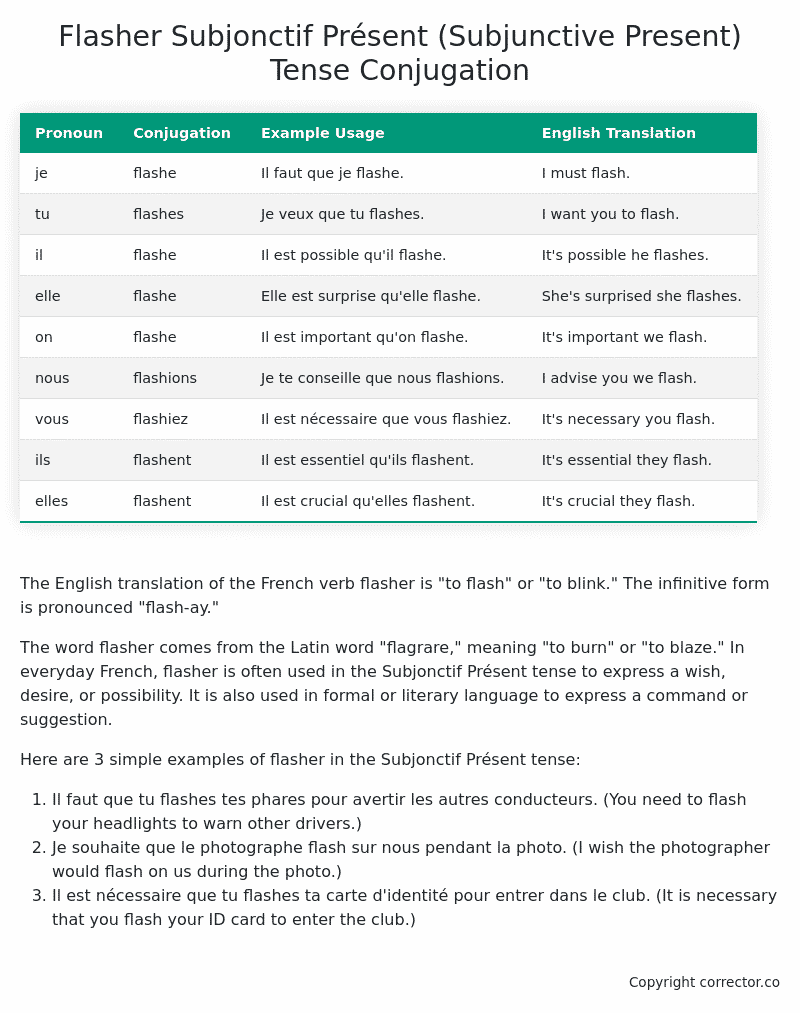Subjonctif Présent (Subjunctive Present) Tense Conjugation of the French Verb flasher
Introduction to the verb flasher
The English translation of the French verb flasher is “to flash” or “to blink.” The infinitive form is pronounced “flash-ay.”
The word flasher comes from the Latin word “flagrare,” meaning “to burn” or “to blaze.” In everyday French, flasher is often used in the Subjonctif Présent tense to express a wish, desire, or possibility. It is also used in formal or literary language to express a command or suggestion.
Here are 3 simple examples of flasher in the Subjonctif Présent tense:
- Il faut que tu flashes tes phares pour avertir les autres conducteurs. (You need to flash your headlights to warn other drivers.)
- Je souhaite que le photographe flash sur nous pendant la photo. (I wish the photographer would flash on us during the photo.)
- Il est nécessaire que tu flashes ta carte d’identité pour entrer dans le club. (It is necessary that you flash your ID card to enter the club.)
Table of the Subjonctif Présent (Subjunctive Present) Tense Conjugation of flasher
| Pronoun | Conjugation | Example Usage | English Translation |
|---|---|---|---|
| je | flashe | Il faut que je flashe. | I must flash. |
| tu | flashes | Je veux que tu flashes. | I want you to flash. |
| il | flashe | Il est possible qu’il flashe. | It’s possible he flashes. |
| elle | flashe | Elle est surprise qu’elle flashe. | She’s surprised she flashes. |
| on | flashe | Il est important qu’on flashe. | It’s important we flash. |
| nous | flashions | Je te conseille que nous flashions. | I advise you we flash. |
| vous | flashiez | Il est nécessaire que vous flashiez. | It’s necessary you flash. |
| ils | flashent | Il est essentiel qu’ils flashent. | It’s essential they flash. |
| elles | flashent | Il est crucial qu’elles flashent. | It’s crucial they flash. |
Other Conjugations for Flasher.
Le Present (Present Tense) Conjugation of the French Verb flasher
Imparfait (Imperfect) Tense Conjugation of the French Verb flasher
Passé Simple (Simple Past) Tense Conjugation of the French Verb flasher
Passé Composé (Present Perfect) Tense Conjugation of the French Verb flasher
Futur Simple (Simple Future) Tense Conjugation of the French Verb flasher
Futur Proche (Near Future) Tense Conjugation of the French Verb flasher
Plus-que-parfait (Pluperfect) Tense Conjugation of the French Verb flasher
Passé Antérieur (Past Anterior) Tense Conjugation of the French Verb flasher
Futur Antérieur (Future Anterior) Tense Conjugation of the French Verb flasher
Subjonctif Présent (Subjunctive Present) Tense Conjugation of the French Verb flasher (this article)
Subjonctif Passé (Subjunctive Past) Tense Conjugation of the French Verb flasher
Subjonctif Imparfait (Subjunctive Imperfect) Tense Conjugation of the French Verb flasher
Subjonctif Plus-que-parfait (Subjunctive Pluperfect) Tense Conjugation of the French Verb flasher
Conditionnel Présent (Conditional Present) Tense Conjugation of the French Verb flasher
Conditionnel Passé (Conditional Past) Tense Conjugation of the French Verb flasher
L’impératif Présent (Imperative Present) Tense Conjugation of the French Verb flasher
L’infinitif Présent (Infinitive Present) Tense Conjugation of the French Verb flasher
Struggling with French verbs or the language in general? Why not use our free French Grammar Checker – no registration required!
Get a FREE Download Study Sheet of this Conjugation 🔥
Simply right click the image below, click “save image” and get your free reference for the flasher Subjonctif Présent tense conjugation!

Flasher – About the French Subjonctif Présent (Subjunctive Present) Tense
Formation of the Subjonctif Présent
Common Everyday Usage Patterns
Interactions with Other Tenses
Summary
I hope you enjoyed this article on the verb flasher. Still in a learning mood? Check out another TOTALLY random French verb conjugation!


